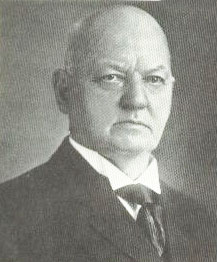
Frank Baldwin
The state of calculating machine design by the 1870s can be seen in a note, appearing in an 1872 issue of the popular US magazine Manufacturer and Builder: ”If a reliable calculating machine could be manufactured to retail at a low price, say five dollars, with which addition, subtraction, multiplication, and division could be done, it would no doubt find a ready-sale, as all go-ahead business men want such a time-saver.
In all wholesale establishments; in banks, government offices, commercial houses, publishing companies, etc., an easily operated calculating machine, simple in construction, reliable in operation, not easily deranged, and substantially made, would be a great desideratum.
In looking over the models of calculating machines in the Patent Office last month, we saw none that answered the above description. Some of them were so complicated that it would take an engineer to run them, and a watch-maker to keep them in order, while others were evidently designed by men who knew nothing, practically, of the working of machinery; they having employed small wooden cams operating without friction rollers on sliding rods which would always stick fast; or, in other cases, strings were used to pull on wheels weighted on one side, and expected to return to their proper position by the action of gravitation, but which they never did, owing to friction, for which the inventor had made no allowance.
Finally, every machine was out of order, and gave arithmetical results that would bankrupt the most successful business man in two turns of the handle.”
One of the first inventors, who tried to change this disappointing situation was Frank Baldwin (1838-1925) (see biography of Frank Baldwin) of St. Louis, Missouri, who in 1873 rented a small shop in Philadelphia and started to make ten of his calculating machines, based on “pinwheel” or “variable cog” mechanism. Baldwin definitely was not the inventor of this mechanism, as he claims later on.
As you can see on other pages on this site, the first similar design was most probably created by Leibniz in 1672, then reinvented by Poleni in 1709, Braun in 1727, Staffel, Roth, and Wertheimber in the 1840s. It is unknown however if Baldwin knew about the other inventors, but especially the machine of Staffel was well-known in the English-speaking world after its success in the Great Exhibition in London in 1851.
Together with this machine, Baldwin designed a simpler one—adding device (see the figure below), which the inventor named Arithmometer, and which later on was successfully manufactured and sold, although in small numbers. His first patent by the United States Patent Office Baldwin received namely for the Arithmometer in 1874 (US patent 153522). Later on in 1900, he took out another patent for an adding device.
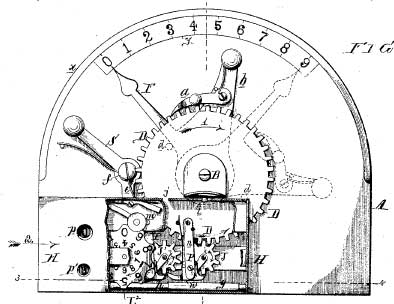
The Arithmometer of Frank Baldwin, patent drawing-up, and the machine (© Monroe Calculator Company)
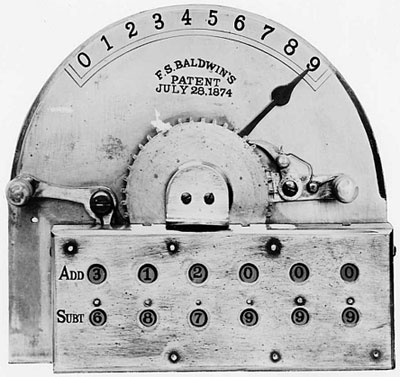
In the same 1874 Baldwin placed both machines on an exhibition at the Franklin Institute, where a committee of John Nystrom, John Groesbeck, and Pliny Earle Chase commented favorably on the smaller machine. That’s why it was awarded the John Scott Medal for the most meritorious invention of the year 1874. Later on, Baldwin managed to sell one of his machines to a railroad office. The machine proved to be very useful and reliable.
It was a steel and brass device, with measurements of 2 cm x 13 cm x 11.3 cm.
The device’s back is roughly a half-disc, with the digits from 0 to 9 engraved across the top. A steel arrow rotates to point to any one of these digits. Rotating a brass knob returns the arrow to place. The knob is linked by gears to a small movable carriage at the base of the device. Returning the knob to its original position rotates two small register wheels.
One of the wheels records the sum of the number entered and the number already set in the wheels (used in addition). The other records the complement of this number (used in subtraction). There are four sets of register wheels, linked to one another so that the machine carries, thus the machine can add numbers up to 9999.
The second patent granted to Baldwin in 1875 (US patent 159244), was for the pin-wheel machine.
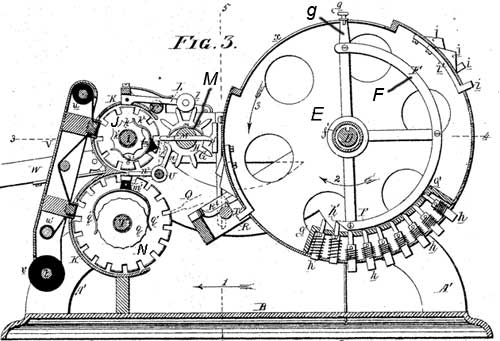
The pin-wheel machine of Frank Baldwin (patent drawing)
Let’s examine the principle of work of the machine, viewing the patent drawing of the first machine:
The basic mechanism of the machine can be divided into three parts.
1. The counter drums (marked in the patent drawing), consist of a basic drum, containing the teeth, and sector segment.
In a normal position, the teeth are hidden in the body of the drum by means of a spring. If the sector segment is rotated by means of the lever, then one or more teeth will be pushed out of the body of the drum by the springs, and the number of these teeth will depend on the angle of rotation of the segment. Thus during the rotation of the crank, which rotates the pin-wheel drum, different numbers of teeth will be engaged with the pinion, and different numbers will be transferred to the resulting mechanism.
The mechanism with the counter drums is separated from the other mechanisms and can be moved leftwards and rightwards by means of a slider (in contrast for example the other famous machine of this class, Odhner’s, in which mechanism can be rotated not counter, but registering mechanism). This movement is necessary during the multiplication and division.
2. After the number has been entered, then must be rotated to one revolution the main handle, and 9-teeth registering drums will be rotated to so many steps, according to the erected teeth of the particular counter drum.
3. Another group of registering drums is connected with the mechanism in such a manner, that it serves as a revolution counter of the particular counter-drum, which is necessary for multiplication and division.
In his first patent, Baldwin proposed also a ribbon-printing device to be used for printing the result on paper. This idea however will be realized as late as 1908, when was patented Baldwin Recording Calculator, which combined the listing machine with the calculator.
After the successful sale of the first 10 produced manual devices, Baldwin tried to manufacture and sell his machine in a factory, but without success. The demand for such machines was too low yet.
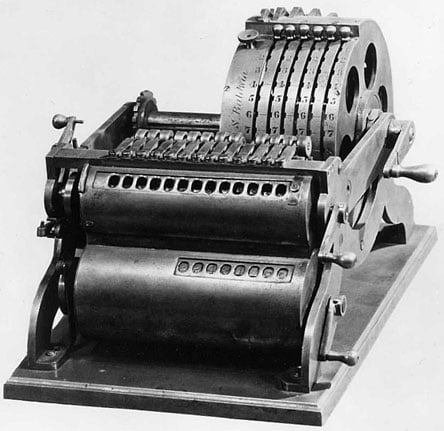
The first pin-wheel machine of Frank Baldwin
Frank Baldwin tried to improve his machine and was granted with other patents, in 1902 and 1904 for improved pin-wheel machine, in 1905 for a machine with a keyboard (see the photo below), and in 1908 for the above-mentioned machine with a printing mechanism.

The machine of Frank Baldwin from 1905
The success came to Baldwin at the end of his life, in 1911, when he received financial support from the young businessman Jay Randolph Monroe (1883-1937), and in 1912 they created the Monroe Calculator Company. Baldwin had developed a machine that combined the best features of the calculators of the time — the four-function arithmetic capabilities of the stepped-drum and pin-wheel machines, and the rapid keyboard setting of the key-driven Comptometer. Monroe recognized the possibilities and established a company to bring the machine to market.
The image featured at the top of this post is ©Unknown author / public domain
